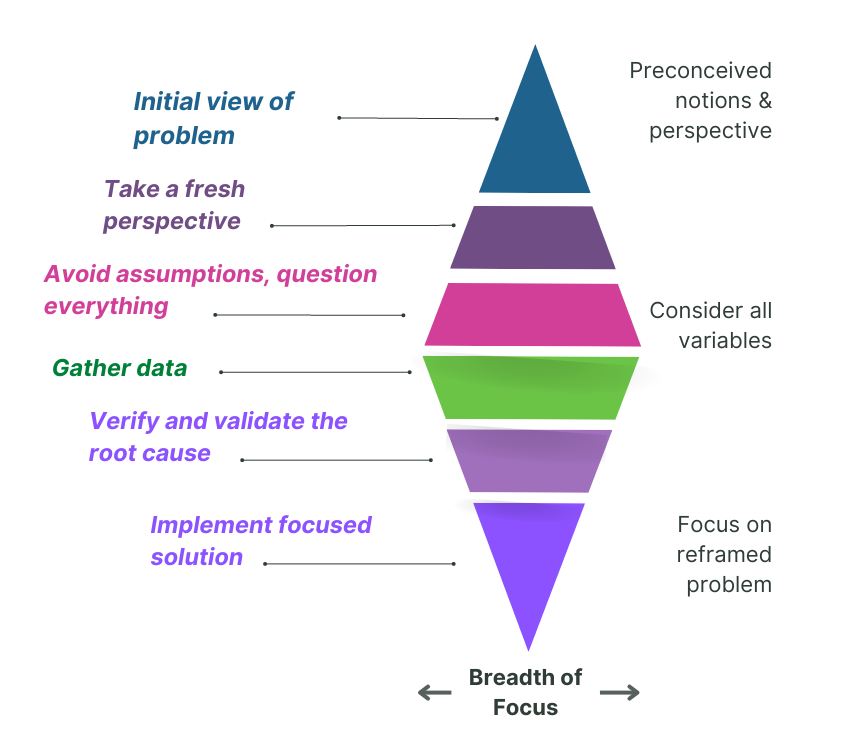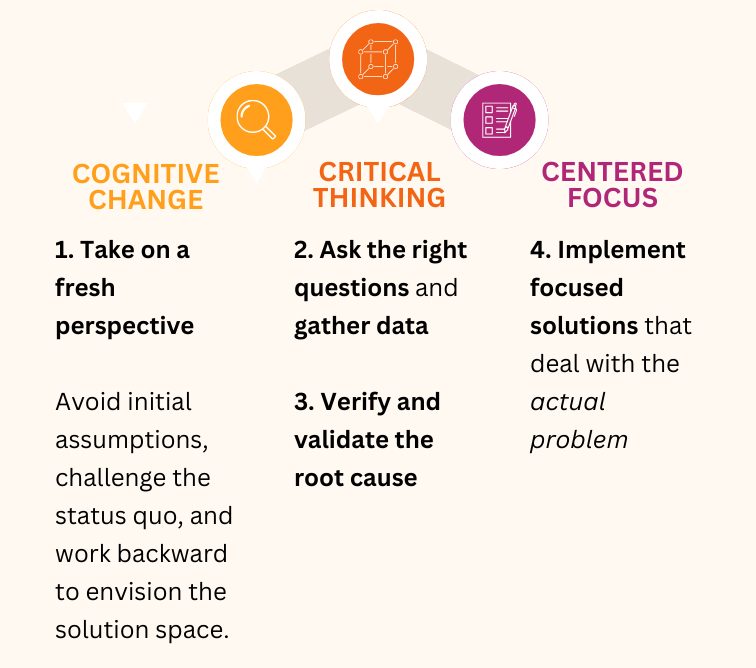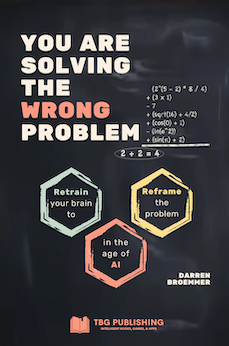From the book "You are Solving the Wrong Problem"Chapter 8: Diamond Pattern
When you follow the three-pillared approach in this book, your problem-solving process follows what we call the Diamond Pattern.

At the beginning, you should expand your scope and conduct extensive research. This is the fan-out phase of the diamond. After gaining sufficient knowledge to reframe the issue, you then narrow your focus and concentrate on resolving the fundamental cause. This is the fan-in portion of the diamond.
The approach is based on the three pillars.

-
Identify the symptoms: First, mentally prepare yourself to adopt a different persona. Step into the shoes of your customer, stakeholder, or someone experiencing the situation for the first time. The specific problem at hand will dictate which persona to assume. Look at the problem through their eyes and document any symptoms that come to light. It is important to note that this exercise does not have to be restricted to paper or theoretical analysis alone. For instance, if you manage a retail store, physically enter the store and browse as a regular customer would. If you develop software, utilize the app as any other user would. This step can also involve employees or members of a focus group who can provide a fresh perspective.
-
Ask the right questions and gather data: Based on the symptoms you have identified, prioritize the areas that warrant further investigation. Begin by asking specific questions about these symptoms. Explore the circumstances or actions that lead to the occurrence of these symptoms. Determine when they tend to happen and if any patterns can be discerned. With each question, aim to delve deeper into understanding the underlying causes. Continuously inquire with a "why" mindset, tracing the lineage of the problem until reaching a fundamental cause, even if it may not be immediately obvious. Engage in conversations with customers, staff, and all those involved in the process. Ask questions persistently, not stopping until you have thoroughly comprehended what is happening and why. Avoid accepting vague or incomplete answers; strive for a comprehensive understanding.
-
Verify and validate the root cause: Commence the process of formulating and testing hypotheses regarding the root cause of the problem. Evaluate whether your assumptions are substantiated by evidence and take into account any other potential contributing factors. If possible, conduct A/B experiments to gather additional data and insights. It is crucial to emphasize the collection of empirical data about the problem at hand. Intuition alone should not be relied upon, and solutions should not be solely based on institutional knowledge. This approach belongs to outdated practices. Instead, aim to identify a new and improved way of addressing the issue.
-
Implement solutions: After identifying the root cause and verifying any assumptions, concentrate your efforts on implementing solutions that effectively address the actual problem. Prioritize solutions that generate enduring fixes, rather than temporary or superficial ones. By focusing on long-lasting solutions, you can ensure sustained improvement.
Use data to prioritize your time
During the fan-out phase of the Diamond Pattern, there are many possible directions your research could take you. Use data to help prioritize where to look for solutions.
The 80/20 rule, also known as the Pareto Principle, is a statistical rule that states that 80% of outcomes result from 20% of causes. The question is which 20%? Data can help you determine this.
Consider your average work week. If you apply the Pareto Principle, 80% of the value you create comes from only 20% of your time. This equates to working just one day a week instead of five, with nearly the same output. What if you could get most of your work done in that one day? Can you imagine what it would be like if you had the other four days to pursue other projects and interests?
If we apply the 80/20 rule recursively a second time, you end up producing 64% of your total output in just over an hour and a half (1.6 hours).
Can you identify the activities performed in that hour and a half? If you had the data, you could. Think about how much extra time you would have. Of course, you would still get stuck attending a few meetings, but no one said life was fair.
Now apply the Pareto Principle to the areas in which you can fan-out your research. Which areas will be worth the time investment? You can use AI to help accelerate your research, and you can also conduct a few experiments.
Experimentation before creation
I am an author. Say for a moment that I published a total of 50 books. Forty-nine of those books sell only a few hundred copies. However, one of them became a New York Times bestseller. This one book is widely popular and sells over 100k copies. Am I a successful author?
I could reframe this story to say that I conducted 49 experiments, and then I got it right on the 50th try. In this version of the story, do you view it any differently?
The life of a problem-solver is to analyze, experiment, and collect more data. Then rinse and repeat.
They say that perfect is the enemy of the good, but good is a precursor to being perfect. You have to start somewhere.
Many problems are solved using lessons learned from simple experiments. Collect data from your experiments, and evaluate the results of each one. Rapid experimentation leads to faster problem-solving. Experiments can be conducted using computer simulations, thought experiments, or physical activities. In the case of physical activities, you generally can't speed up the process. However, AI gives us the superpower to speed up the data analysis. We will talk more about data analysis in an upcoming chapter.
When to use trial and error
Trial and error is easy. It doesn't require much up-front effort. Try a few things and see what happens. You might solve the problem on the first try. You might learn a few things. Unfortunately, this technique can also end in frustration. The following table highlights productive uses of the trial-and-error method, as well as use cases we don't recommend.
| Recommended uses | Avoid these scenarios |
|---|---|
| Small solution-space problems | Large solution-space problems |
| To learn more about the problem | "Finding a needle in a haystack" |
If there are 10 possible answers, then randomly trying a few makes sense. If there are 100,000 possibilities, you will give up on trial and error long before finding a solution. It can be used as research, however. Experimentation using trial and error can be productive, in that incorrect answers can reveal things about the problem itself. Puzzles are a great example of this. Trying a few things may produce an answer, but it may lead to an insight or process we can use to find the answer.
Innovation and reframing requires us to understand the true nature of the problem. Sometimes, our own mind can get in the way. This is what we examine next.
Chapters
2. Step out of Auto-Pilot Mode
3. Your most important skill: Asking Questions
4. Solve any problem using the Five Whys
5. AI Prompting like a Pro
6. Invention over Convention
7. How to Reframe a Problem to your Advantage
8. The Diamond Pattern: First fan-out, then fan-in
9. The Problem Paradox
10. Break free from Cognitive Bias
11. From Complex to Simple
13. Use AI for Data Analysis
14. The Curiosity Rule
15. Improve productivity by eliminating distractions
16. Optimization Problems
17. Greenfield or work within current constraints
18. Managing the most scarce resource: Time
19. Challenge yourself with Puzzles
20. Next Steps
21. Solutions to Puzzles

